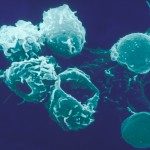Lien vers Pubmed [PMID] – 33692218
Lien DOI – e00194810.1136/jitc-2020-001948
J Immunother Cancer 2021 Mar; 9(3):e001948
Resident memory T lymphocytes (TRM) are located in tissues and play an important role in immunosurveillance against tumors. The presence of TRM prior to treatment or their induction is associated to the response to anti-Programmed cell death protein 1 (PD-1)/Programmed death-ligand 1 (PD-L1) immunotherapy and the efficacy of cancer vaccines. Previous work by our group and others has shown that the intranasal route of vaccination allows more efficient induction of these cells in head and neck and lung mucosa, resulting in better tumor protection. The mechanisms of in vivo migration of these cells remains largely unknown, apart from the fact that they express the chemokine receptor CXCR6.We used CXCR6-deficient mice and an intranasal tumor vaccination model targeting the Human Papillomavirus (HPV) E7 protein expressed by the TC-1 lung cancer epithelial cell line. The role of CXCR6 and its ligand, CXCL16, was analyzed using multiparametric cytometric techniques and Luminex assays.Human biopsies obtained from patients with lung cancer were also included in this study.We showed that CXCR6 was preferentially expressed by CD8+ TRM after vaccination in mice and also on intratumoral CD8+ TRM derived from human lung cancer. We also demonstrate that vaccination of Cxcr6-deficient mice induces a defect in the lung recruitment of antigen-specific CD8+ T cells, preferentially in the TRM subsets. In addition, we found that intranasal vaccination with a cancer vaccine is less effective in these Cxcr6-deficient mice compared with wild-type mice, and this loss of efficacy is associated with decreased recruitment of local antitumor CD8+ TRM. Interestingly, intranasal, but not intramuscular vaccination induced higher and more sustained concentrations of CXCL16, compared with other chemokines, in the bronchoalveolar lavage fluid and pulmonary parenchyma.This work demonstrates the in vivo role of CXCR6-CXCL16 axis in the migration of CD8+ resident memory T cells in lung mucosa after vaccination, resulting in the control of tumor growth. This work reinforces and explains why the intranasal route of vaccination is the most appropriate strategy for inducing these cells in the head and neck and pulmonary mucosa, which remains a major objective to overcome resistance to anti-PD-1/PD-L1, especially in cold tumors.

